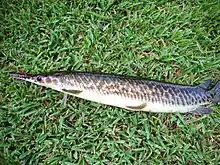Lepisosteus
Lepisosteus is a genus of gars in the family Lepisosteidae.
| Lepisosteus | |
|---|---|
 | |
| Longnose gar, Lepisosteus osseus | |
| Scientific classification | |
| Kingdom: | Animalia |
| Phylum: | Chordata |
| Class: | Actinopterygii |
| Order: | Lepisosteiformes |
| Family: | Lepisosteidae |
| Genus: | Lepisosteus Lacepède, 1803 |
| Species | |
|
See text | |
| Synonyms[2][3] | |
| |
Distribution
While in the present day, Lepisosteus is only known across North America, fossil remains show it was much more widespread in the past, with specimens known from the Cretaceous of India and Brazil.
Systematics
| Lepisosteidae |
| ||||||||||||||||||||||||||||||||||||
Species
The currently recognized species are:[4]
Extant species
| Image | Scientific name | Common name | Distribution |
|---|---|---|---|
 | Lepisosteus oculatus Winchell 1864 | Spotted gar | North America |
 | Lepisosteus osseus Linnaeus, 1758 | Longnose gar | east coast of North and Central America in freshwater lakes and as far west as Kansas and Texas and southern New Mexico |
.jpg.webp) | Lepisosteus platostomus Rafinesque 1820 | Shortnose gar | Montana to the west and the Ohio River to the east, southwards to the Gulf Coast. |
 | Lepisosteus platyrhincus DeKay 1842 | Florida gar | USA from the Savannah River and Ochlockonee River watersheds of Georgia and throughout peninsular Florida |
Fossil species
- †Lepisosteus aganus (Cope 1877)
- †Lepisosteus bemisi Grande 2010
- †Lepisosteus bohemicus (Laube 1901)
- †Lepisosteus cominatoi Santos 1984
- †Lepisosteus cycliferus (Cope 1873)
- †Lepisosteus glaber Marsh 1871
- †Lepisosteus indicus Woodward 1908
- †Lepisosteus integer (Cope 1877)
- †Lepisosteus fimbriatus Wood 1846
- †Lepisosteus knieskerni Fowler 1911
- †Lepisosteus longus Lambe 1908
- †Lepisosteus nahunticus (Cope 1869)
- †Lepisosteus notabilis Leidy 1873
- †L. occidentalis[5][6]
- †Lepisosteus opertus Estes 1964
- †Lepisosteus strausi Kinkelin 1884
- †Lepisosteus suessoniensis Gervais 1888
- †Lepisosteus whitneyi Marsh 1871
Three species formerly classified in Lepisosteus (Tropical gar, Cuban gar, and Alligator gar) are now assigned to the genus Atractosteus.
References
- Sepkoski, Jack (2002). "A compendium of fossil marine animal genera". Bulletins of American Paleontology. 363: 1–560. Archived from the original on 2011-07-23. Retrieved 2008-01-08.
- Froese, R.; Pauly, D. (2017). "Lepisosteidae". FishBase version (02/2017). Retrieved 18 May 2017.
- "Lepisosteidae" (PDF). Deeplyfish- fishes of the world. Retrieved 18 May 2017.
- Haaramo, Mikko (2007). "Lepisosteiformes – gars and relatives". Mikko's Phylogeny Archive. Retrieved 3 July 2017.
- Pearson et al., 2002, p.154
- "Class Osteichthyes," in Estes and Berberian, 1970, p.3
External links
- Froese, Rainer and Pauly, Daniel, eds. (2011). Species of Lepisosteus in FishBase. June 2011 version.
This article is issued from Wikipedia. The text is licensed under Creative Commons - Attribution - Sharealike. Additional terms may apply for the media files.